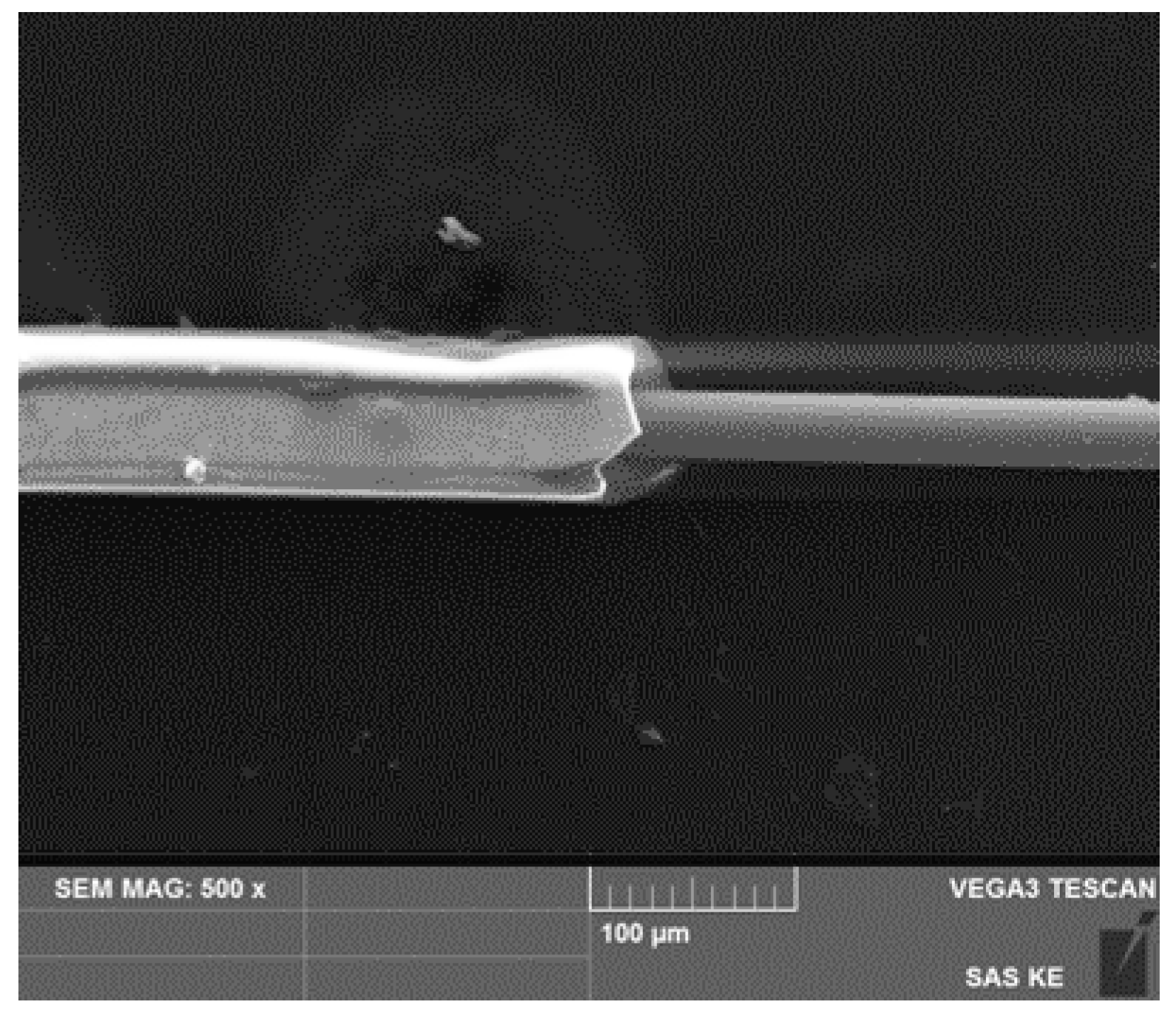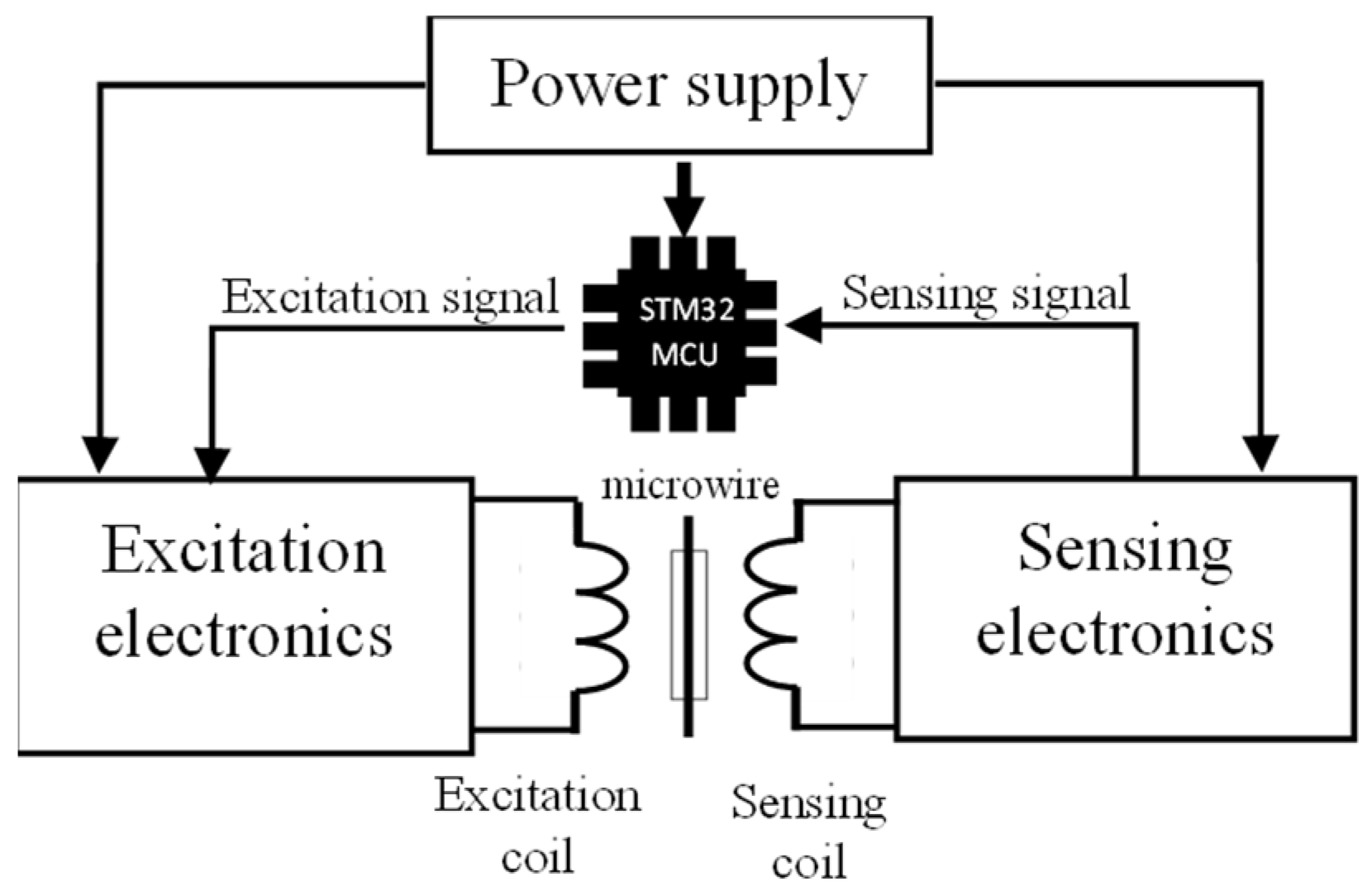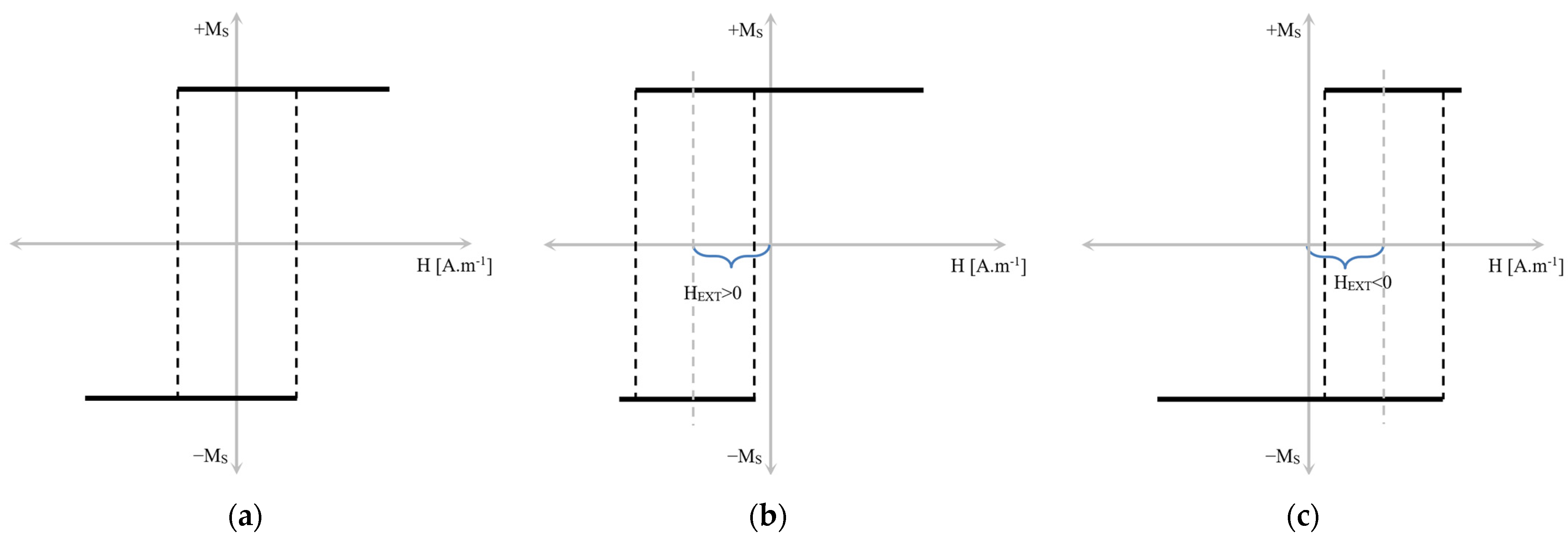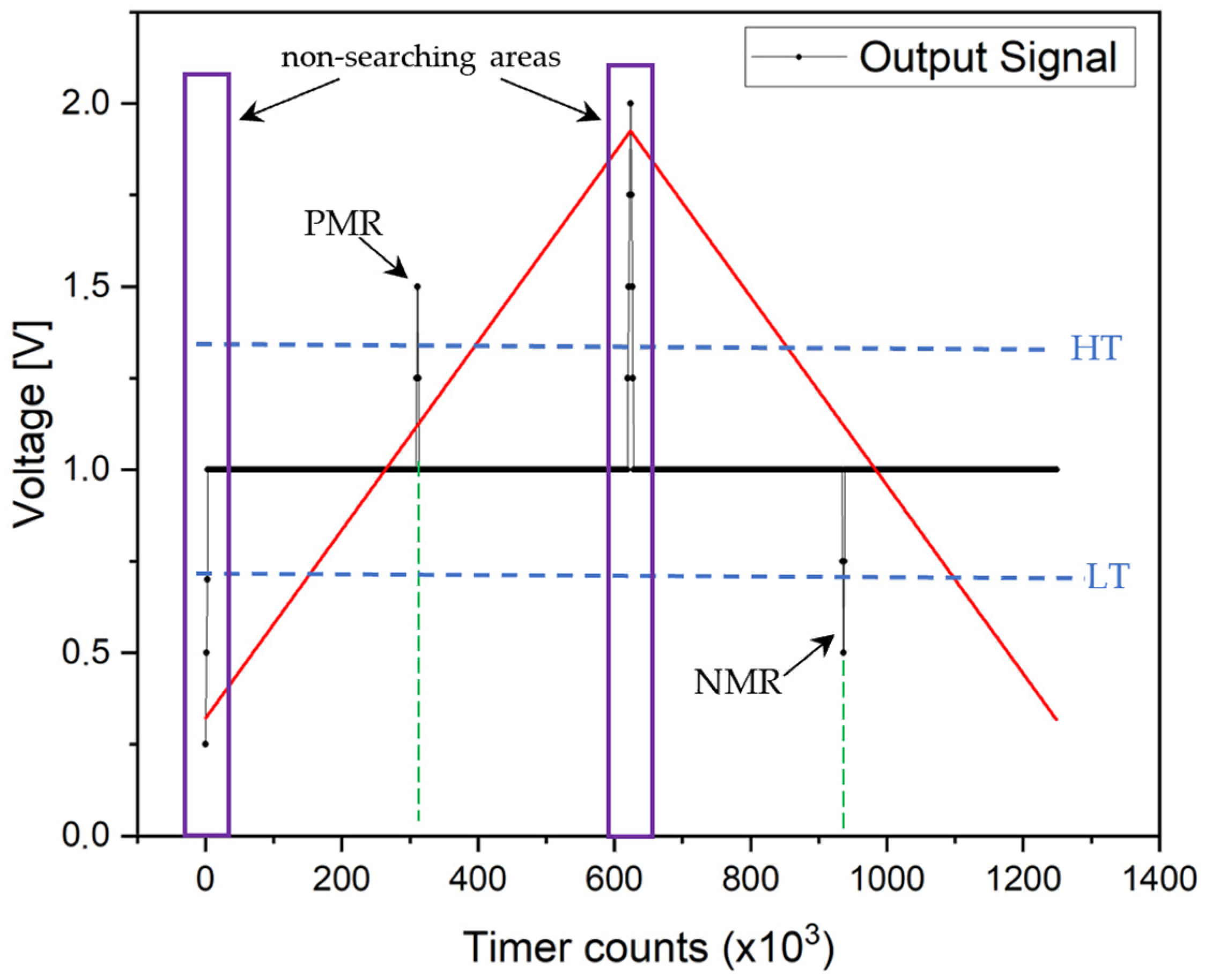Advantages of Bistable Microwires in Digital Signal Processing
Abstract
1. Introduction
2. Materials and Methods
2.1. Magnetic Microwire
2.2. Coils System and Switching Time Measurement
- Miniature coil system without a ferromagnetic core.
- Coil system with a ferromagnetic core.
2.3. Microcontroller
- An internal analog comparator processing with a timer of STM32G474RE.
- Single-period processing via an ADC (analog-to-digital converter).
- Sample averaging via ADC.
- The utilization of digital FIR (finite impulse response).
2.4. Analog Comparator Processing
2.5. Sample Averaging
2.6. FIR Filtering
3. Results
3.1. Experiment without Magnetic Background
3.1.1. Experiment without Magnetic Background and without an Analog RC Filter
3.1.2. Experiment without Magnetic Background and with Analog RC Filter
3.2. Experiment with Magnetic Background in Excitation coil
3.2.1. Experiment with Magnetic Background in Excitation Coil and without Analog RC Filter
3.2.2. Experiment with Magnetic Background in Excitation Coil and with Analog RC Filter
3.3. Experiment with Feromagnetic Core and External Magnetic Background
3.3.1. Experiment with Ferromagnetic Core, External Magnetic Background, and without Analog RC Filter
3.3.2. Experiment with Ferromagnetic Core, External Magnetic Background and with Analog RC Filter
4. Discussion
5. Conclusions
- An internal analog comparator processing with a timer of STM32G474RE.
- Single-period processing via internal ADC.
- Sample averaging via internal ADC.
- The utilization of a digital FIR filter.
- An experiment without a magnetic background.
- An experiment with a magnetic background in the excitation coil.
- An experiment with a ferromagnetic core and external magnetic field.
Author Contributions
Funding
Institutional Review Board Statement
Informed Consent Statement
Data Availability Statement
Acknowledgments
Conflicts of Interest
References
- Honkura, Y.; Honkura, S. The development of ASIC type GSR sensor driven by GHz pulse current. Sensors 2020, 20, 1023. [Google Scholar] [CrossRef]
- Zhao, Y.J.; Zheng, X.F.; Qin, F.X.; Estevez, D.; Luo, Y.; Wang, H.; Peng, H.X. A self-sensing microwire/epoxy composite optimized by dual interfaces and periodical structural integrity. Compos. B Eng. 2020, 182, 107606. [Google Scholar] [CrossRef]
- Spodniak, M.; Semrád, K.; Hovanec, M.; Korba, P.; Musil, T. FEM modeling of magnetic microwire and it is using for stress monitoring inside the composite beam. Metalurgija 2020, 59, 411–414. [Google Scholar]
- Jacko, P.; Jurč, R.; Galdun, L.; Hvizdoš, Ľ.; Kováč, D.; Varga, R. Linear position sensor using magnetically bistable microwire. Sens. Actuators A Phys. 2023, 349, 114017. [Google Scholar] [CrossRef]
- Herrero-Gómez, C.; Aragón, A.M.; Hernando-Rydings, M.; Marín, P.; Hernando, A. Stress and field contactless sensor based on the scattering of electromagnetic waves by a single ferromagnetic microwire. Appl. Phys. Lett. 2014, 105, 092405. [Google Scholar] [CrossRef]
- Baranov, S.A.; Larin, V.S.; Torcunov, A.V. Technology, preparation and properties of the cast glass-coated magnetic microwires. Crystals 2017, 7, 136. [Google Scholar] [CrossRef]
- Morales, I.; Archilla, D.; de la Presa, P.; Hernando, A.; Marin, P. Colossal heating efficiency via eddy currents in amorphous microwires with nearly zero magnetostriction. Sci. Rep. 2020, 10, 602. [Google Scholar] [CrossRef] [PubMed]
- Šmelko, M.; Draganová, K.; Lipovský, P.; Semrád, K.; Blišťanová, M.; Kašper, P. Non-Destructive testing of aircraft structures using microwire-based tensile stress sensor. Appl. Sci. 2020, 10, 8218. [Google Scholar] [CrossRef]
- Ripka, P.; Blažek, J.; Mirzaei, M.; Lipovský, P.; Šmelko, M.; Draganová, K. Inductive position and speed sensors. Sensors 2019, 20, 65. [Google Scholar] [CrossRef]
- Shang, W.; Wang, C.; Duan, L.; Liu, Q.; Wu, Z. Metallic glass microwire defects detection using dynamic nanorobotic control. IEEE Trans. Nanotechnol. 2018, 17, 662–665. [Google Scholar] [CrossRef]
- Vereshchagin, M.; Baraban, I.; Leble, S.; Rodionova, V. Structure of head-to-head domain wall in cylindrical amorphous ferromagnetic microwire and a method of anisotropy coefficient estimation. J. Magn. Magn. Mater. 2020, 504, 166646. [Google Scholar] [CrossRef]
- Ziman, J.; Onufer, J.; Kladivová, M. Domain wall dynamics and Hall effect in eddy current loop in amorphous ferromagnetic wire with small helical anisotropy. Phys. Rev. B Condens. 2011, 406, 3576–3582. [Google Scholar] [CrossRef]
- Chizhik, A.; Corte-León, P.; Zhukova, V.; Gonzalez, J.; Zhukov, A. Longitudinal Transformation of Magnetic Properties in Magnetic Microwires with Graded Magnetic Anisotropy. IEEE Magn. Lett. 2022, 13, 7104905. [Google Scholar] [CrossRef]
- Churyukanova, M.; Semenkova, V.; Kaloshkin, S.; Shuvaeva, E.; Gudoshnikov, S.; Zhukova, V.; Zhukov, A. Magnetostriction investigation of soft magnetic microwires. Phys. Status Solidi A Appl. Mater. 2016, 213, 363–367. [Google Scholar] [CrossRef]
- Berdugin, A.I.; Vigovskiy, V.U.; Badin, A.V.; Kuleshov, G.E. Anisotropic materials based on magnetic microwires in EHF range. Key Eng. Mater. 2017, 743, 81–85. [Google Scholar] [CrossRef]
- Ziman, J.; Onufer, J.; Kladivová, M. DC magnetization processes in bistable glass-coated ferromagnetic microwires. J. Magn. Magn. Mater. 2011, 323, 3098–3103. [Google Scholar] [CrossRef]
- Yang, Z.; Wang, Z.; Liu, M.; Sun, X. Non-Contact Current Sensing System Based on the Giant Magnetoimpedance Effect of CoFeNiSiB Amorphous Ribbon Meanders. Micromachines 2024, 15, 161. [Google Scholar] [CrossRef] [PubMed]
- Gonzalez, J.M.; Garcia-Arribas, A.; Shcherbinin, S.V.; Lepalovskij, V.N.; Collantes, J.M.; Kurlyandskaya, G.V. Broadband ferromagnetic resonance measurements in thin-film structures for magnetoimpedance sensors. Measurement 2018, 126, 215–222. [Google Scholar] [CrossRef]
- Zhukov, A.; Talaat, A.; Ipatov, M.; del Val, J.J.; Gonzalez-Legarreta, L.; Hernando, B.; Zhukova, V. Giant magnetoimpedance effect of amorphous and nanocrystalline glass-coated microwires. Next Gener. Sens. Syst. 2016, 16, 103–130. [Google Scholar]
- Zhukov, A.; Chizhik, A.; Ipatov, M.; Talaat, A.; Blanco, J.M.; Stupakiewicz, A.; Zhukova, V. Giant magnetoimpedance effect and domain wall dynamics in Co-rich amorphous microwires. J. Appl. Phys. 2015, 117, 043904. [Google Scholar] [CrossRef]
- Groves, E.M.; Charles, A.D.; Rider, A.N. Tuning the giant magnetoimpedance response of a glass-coated microwire reinforced polymer by in-situ laser annealing. Sens. Actuator A-Phys. 2023, 359, 114493. [Google Scholar] [CrossRef]
- Gudoshnikov, S.; Tarasov, V.; Liubimov, B.; Odintsov, V.; Venediktov, S.; Nozdrin, A. Scanning magnetic microscope based on magnetoimpedance sensor for measuring of local magnetic fields. J. Magn. Magn. Mater. 2020, 510, 166938. [Google Scholar] [CrossRef]
- Popov, V.V.; Buznikov, N.A. Modeling the giant magnetoimpedance effect in amorphous microwires with induced magnetic anisotropy. Phys. Met. Metallogr. 2020, 121, 1033–1038. [Google Scholar] [CrossRef]
- Zhukova, V.; Corte-Leon, P.; Ipatov, M.; Blanco, J.M.; Gonzalez-Legarreta, L.; Zhukov, A. Development of magnetic microwires for magnetic sensor applications. Sensors 2019, 19, 4767. [Google Scholar] [CrossRef] [PubMed]
- Corte-León, P.; Gonzalez-Legarreta, L.; Zhukova, V.; Ipatov, M.; Blanco, J.M.; Churyukanova, M.; Zhukov, A. Controlling the domain wall dynamics in Fe-, Ni-and Co-based magnetic microwires. J. Alloys Compd. 2024, 834, 155170. [Google Scholar] [CrossRef]
- Kurlyandskaya, G.V.; Shcherbinin, S.V.; Volchkov, S.O.; Bhagat, S.M.; Calle, E.; Pérez, R.; Vazquez, M. Soft magnetic materials for sensor applications in the high frequency range. J. Magn. Magn. Mater. 2018, 459, 154–158. [Google Scholar] [CrossRef]
- Zhukov, A.; Ipatov, M.; Corte-León, P.; Gonzalez-Legarreta, L.; Blanco, J.M.; Zhukova, V. Soft magnetic microwires for sensor applications. J. Magn. Magn. Mater. 2020, 498, 166180. [Google Scholar] [CrossRef]
- Lejeune, B.T.; Gueye, P.G.B.; Sanz, D.A.; Navarro, E.; Vazquez, M.; del Real, R.P.; Marín, P. High-Sensitivity Wireless Sensing Using Amorphous Magnetic Microwires. IEEE Sens. J. 2022, 23, 1099–1104. [Google Scholar] [CrossRef]
- Wang, T.; Wang, B.; Liu, S.; Luo, Y.; Li, H.; Liu, M.; Xie, S. Large negative tension-impedance effect in a soft ferromagnetic microwire. Europhys. Lett. 2020, 131, 60002. [Google Scholar] [CrossRef]
- Janutka, A.; Brzuszek, K. Giant magnetoreactance in magnetic nanowires. J. Magn. Magn. Mater. 2020, 515, 167297. [Google Scholar] [CrossRef]
- Caposciutti, G.; Marracci, M.; Trigona, C.; Baglio, S.; Tellini, B. A temperature measurement method based on time parameters associated to CoFeSiB microwire magneto-thermal behavior. Measurement 2024, 224, 113963. [Google Scholar] [CrossRef]
- Zhukova, V.; Corte-Leon, P.; Allue, A.; Gondra, K.; Ipatov, M.; Blanco, J.M.; Zhukov, A. Magnetic Properties and Applications of Glass-coated Ferromagnetic Microwires. Adv. Electromagn. 2023, 12, 69–74. [Google Scholar] [CrossRef]
- Chiriac, H.; Óvári, T.A. Amorphous glass-covered magnetic wires: Preparation, properties, applications. Prog. Mater. Sci. 1996, 40, 333–407. [Google Scholar] [CrossRef]
- Larin, V.S.; Torcunov, A.V.; Zhukov, A.; Gonzalez, J.; Vazquez, M.; Panina, L. Preparation and properties of glass-coated microwires. J. Magn. Magn. Mater. 2002, 249, 39–45. [Google Scholar] [CrossRef]
- Chiriac, H. Preparation and characterization of glass covered magnetic wires. Mater. Sci. Eng. A. 2001, 304, 166–171. [Google Scholar] [CrossRef]
- Vázquez, M.; Chiriac, H.; Zhukov, A.; Panina, L.; Uchiyama, T. On the state-of-the-art in magnetic microwires and expected trends for scientific and technological studies. Phys. Status Solidi A Appl. Mater. 2011, 208, 493–501. [Google Scholar] [CrossRef]
- Jurc, R.; Frolova, L.; Kozejova, D.; Fecova, L.; Hennel, M.; Galdun, L.; Varga, R. Sensoric Application of Glass-Coated Magnetic Microwires in Magnetic Nano-and Microwires; Woodhead Publishing: Sawston, UK, 2020. [Google Scholar]
- Chiriac, H.; Vázquez, M.; Hernando, A. Magnetic hysteresis in glass-covered and water-quenched amorphous wires. J. Magn. Magn. Mater. 1998, 177–181 Pt 1, 205–206. [Google Scholar] [CrossRef]
- Praslicka, D.; Blazek, J.; Smelko, M.; Hudák, J.; Cverha, A.; Mikita, I.; Zhukov, A. Possibilities of measuring stress and health monitoring in materials using contact-less sensor based on magnetic microwires. IEEE Trans. Magn. 2012, 49, 128–131. [Google Scholar] [CrossRef]
- STMicroelectronics. STM32G474RE Datasheet. STM32G4 Series: Ultra-Low-Power STM32G4 Series 32-Bit MCUs. Available online: https://www.st.com/resource/en/datasheet/stm32g474re.pdf (accessed on 17 January 2024).
- STMicroelectronics. STM32G4 Reference Manual. STM32G4 Series: Ultra-Low-Power STM32G4 Series 32-Bit MCUs. Available online: https://www.st.com/resource/en/reference_manual/rm0440-stm32g4-series-advanced-armbased-32bit-mcus-stmicroelectronics.pdf (accessed on 17 January 2024).
- Hu, C.L. Design and verification of FIR filter based on Matlab and DSP. In Proceedings of the 2012 International Conference on Image Analysis and Signal Processing, Huangzhou, China, 9–11 November 2012; pp. 1–4. [Google Scholar]
- Gunasekaran, M.; Ramesh, G.P. Design of digital FIR filters for low power applications. In Intelligent Computing in Engineering, 1st ed.; Springer Nature: Singapore, 2020; Volume 1, pp. 433–440. [Google Scholar]
- Swetha, S.; Siva Sankara Reddy, N. Design of FIR Filter Using Low-Power and High-Speed Carry Select Adder for Low-Power DSP Applications. IETE J. Res. 2023, 1–14. [Google Scholar] [CrossRef]
- Li, M.; Wang, J.; Chen, Q.; Ke, L. The accomplishment of the design of FIR electric filter based on MATLAB program. J. Electr. Power 2008, 23, 87–90. [Google Scholar]
- Roy, S.; Chandra, A. A survey of fir filter design techniques: Low-complexity, narrow transition-band and variable bandwidth. Integration 2021, 77, 193–204. [Google Scholar] [CrossRef]
- Hannah, A.A.; Agordzo, G.K. A Design of a low-pass FIR filter using Hamming Window Functions in Matlab. Comput. Eng. Intell. Syst. 2020, 11, 24–30. [Google Scholar]
- Chakraborty, S. Advantages of Blackman window over hamming window method for designing FIR filter. J. Comput. Sci. Eng. Technol. 2013, 4, 1181–1189. [Google Scholar]
- Mistialustina, H.; Irawan, B.; Munir, A. Analytical comparison of Blackman and Kaiser functions for power weighted linear array antennas with small number of elements. In Proceedings of the 2020 International Workshop on Antenna Technology (iWAT), Bucharest, Romania, 25–28 February 2020; pp. 1–4. [Google Scholar]
- Shayesteh, M.G.; Mottaghi-Kashtiban, M. An efficient window function for design of FIR filters using IIR filters. In Proceedings of the IEEE EUROCON 2009, St. Petersburg, Russia, 18–23 May 2009; pp. 1443–1447. [Google Scholar]



















| Signal Processing Method | Positive Microwire Response | Negative Microwire Response | t1 (µs) | t2 (µs) | Processing Time (ms) |
|---|---|---|---|---|---|
| Reference positions | - | - | 2002 | 6443 | - |
| Original signal | 1617 | 5220 | 1998 | 6449 | 12.177 |
| Averaged signal by 100 | 1620 | 5214 | 2001 | 6441 | 748.107 |
| Output from FIR filter | 1619 | 5203 | 2000 | 6428 | 50.219 |
| Analog comparators | 340,789 | 1,093,830 | 2004 | 6434 | 7.407 |
| Signal Processing Method | Positive Microwire Response | Negative Microwire Response | t1 (µs) | t2 (µs) | Processing Time (ms) |
|---|---|---|---|---|---|
| Reference positions | - | - | 2304 | 5995 | - |
| Original signal | 1863 | 4845 | 2302 | 5985 | 12.864 |
| Averaged signal by 100 | 1867 | 4856 | 2306 | 5999 | 748.107 |
| Output from FIR filter | 1860 | 4844 | 2297 | 5984 | 50.219 |
| Analog comparators | 388,960 | 1,008,440 | 2288 | 5932 | 7.407 |
| Signal Processing Method | Positive Microwire Response | Negative Microwire Response | t1 (µs) | t2 (µs) | Processing Time (ms) |
|---|---|---|---|---|---|
| Reference positions | - | - | 1875 | 6312 | - |
| Original signal | 1519 | 5086 | 1876 | 6283 | 12.571 |
| Averaged signal by 100 | 1518 | 5113 | 1875 | 6316 | 748.107 |
| Output from FIR filter | 1516 | 5089 | 1872 | 6287 | 50.219 |
| Analog comparators | N/A | N/A | N/A | N/A | N/A |
| Signal Processing Method | Positive Microwire Response | Negative Microwire Response | t1 (µs) | t2 (µs) | Processing Time (ms) |
|---|---|---|---|---|---|
| Reference positions | - | - | 1810 | 6409 | - |
| Original signal | 1475 | 5195 | 1822 | 6418 | 11.973 |
| Averaged signal by 100 | 1466 | 5189 | 1811 | 6410 | 748.107 |
| Output from FIR filter | 1460 | 5184 | 1800 | 6404 | 50.219 |
| Analog comparators | 303,324 | 1,085,889 | 1784 | 6387 | 7.407 |
| Signal Processing Method | Positive Microwire Response | Negative Microwire Response | t1 (µs) | t2 (µs) | Processing Time (ms) |
|---|---|---|---|---|---|
| Reference positions | - | - | 1275 | 6475 | - |
| Original signal | - | - | - | - | - |
| Averaged signal by 100 | 1340 | 5241 | 1277 | 6474 | 748.107 |
| Output from FIR filter | 1320 | 5248 | 1274 | 6483 | 50.219 |
| Analog comparators | N/A | N/A | N/A | N/A | N/A |
| Signal Processing Method | Positive Microwire Response | Negative Microwire Response | t1 (µs) | t2 (µs) | Processing Time (ms) |
|---|---|---|---|---|---|
| Reference positions | - | - | 1900 | 5845 | - |
| Original signal | 1573 | 4682 | 1943 | 5784 | 12.169 |
| Averaged signal by 100 | 1537 | 4735 | 1899 | 5849 | 748.107 |
| Output from FIR filter | 1542 | 4720 | 1904 | 5831 | 49.437 |
| Analog comparators | N/A | N/A | N/A | N/A | N/A |
Disclaimer/Publisher’s Note: The statements, opinions and data contained in all publications are solely those of the individual author(s) and contributor(s) and not of MDPI and/or the editor(s). MDPI and/or the editor(s) disclaim responsibility for any injury to people or property resulting from any ideas, methods, instructions or products referred to in the content. |
© 2024 by the authors. Licensee MDPI, Basel, Switzerland. This article is an open access article distributed under the terms and conditions of the Creative Commons Attribution (CC BY) license (https://creativecommons.org/licenses/by/4.0/).
Share and Cite
Jacko, P.; Duranka, P.; Varga, R. Advantages of Bistable Microwires in Digital Signal Processing. Sensors 2024, 24, 2423. https://doi.org/10.3390/s24082423
Jacko P, Duranka P, Varga R. Advantages of Bistable Microwires in Digital Signal Processing. Sensors. 2024; 24(8):2423. https://doi.org/10.3390/s24082423
Chicago/Turabian StyleJacko, Patrik, Peter Duranka, and Rastislav Varga. 2024. "Advantages of Bistable Microwires in Digital Signal Processing" Sensors 24, no. 8: 2423. https://doi.org/10.3390/s24082423
APA StyleJacko, P., Duranka, P., & Varga, R. (2024). Advantages of Bistable Microwires in Digital Signal Processing. Sensors, 24(8), 2423. https://doi.org/10.3390/s24082423






